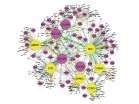(Press-News.org) PROVIDENCE, R.I. [Brown University] — Type 2 diabetes (T2D) and cardiovascular disease (CVD) appear to have a lot in common. They share risk factors such as obesity and they often occur together. If they also share the same genetic underpinings, then doctors could devise a way to treat them together too. With that hope in mind, scientists applied multiple layers of analysis to the genomics of more than 15,000 women. In a new study they report finding eight molecular pathways shared in both diseases as well as several "key driver" genes that appear to orchestrate the gene networks in which these pathways connect and interact.
The scientists started by looking for individual genetic differences in women of three different ethnicities who had either or both of the conditions compared to similar but healthy women – a technique called a Genome Wide Association Study (GWAS). But the team members didn't stop there. They also analyzed the women's genetic differences in the context of the complex pathways in which genes and their protein products interact to affect physiology and health.
"Looking at genes one by one is standard," said Dr. Simin Liu, professor of epidemiology and medicine in the Brown University School of Public Health and a co-senior author of the study published in the American Heart Association journal Circulation: Cardiovascular Genetics. "But ultimately, the interactions of biology are fundamentally organized in a pathway and network manner."
The study drew upon the genetic samples and health records of 8,155 black women, 3,494 Hispanic women and 3,697 white women gathered by the Women's Health Initiative, a major research project funded by the National Heart, Lung and Blood Institute. In comparing women with CVD and T2D to healthy women, lead author Kei Hang K. Chan, a postdoctoral fellow at the Center for Population Health and Clinical Epidemiology, and the team found key differences in eight pathways regulating cell adhesion (how cells stick within tissues), calcium signaling (how cells communicate), axon guidance (how neurons find their paths to connect with target sites), extracellular matrix (structural support within tissue), and various forms of cardiomyopathy (heart muscle problems).
These were all common across ethnicities. In addition the team found a few pathways that were ethnicity-specific between T2D and CVD.
Chan used five different methodologies to conduct these pathway analyses, reporting only those pathways that showed up as significant by at least two methods.
From there, the analysis moved further by subjecting the genes and their pathways to a network analysis to identify genes that could be "key drivers" of the diseases. The paper highlights a "top ten" list of them.
"These [key driver] genes represent central network genes which, when perturbed, can potentially affect a large number of genes involved in the CVD and T2D pathways and thus exert stronger impact on diseases," wrote the authors, including co-senior author Xia Yang of the University of California–Los Angeles.
Potential therapeutic targets
To assess whether those genes made sense as key drivers, the research team looked them up in multiple databases that researchers have compiled about the importance of the genes in the health of mouse models.
In the paper they discuss the pathways they implicate in terms of how they could reasonably relate to the disease. For example, axon guidance, normally of note in how developing fetuses build the nervous system, involves mechanisms that also happen to sustain beta cells in the pancreas, which lies at the heart of diabetes. A breakdown in that pathway could leave the cells more vulnerable, affecting the processing of sugars.
With the pathways and key driver genes identified, Liu said, there are now ample opportunities for follow-up, both to refine the understanding of the role these pathways may play in vascular health outcomes and to design and test treatments that may repair them.
"Using a systems biology framework that integrates GWAS, pathways, gene expression, networks, and phenotypic information from both human and mouse populations, we were able to derive novel mechanistic insights and identify potential therapeutic targets," the researchers wrote.
INFORMATION:
In addition to Liu, Chan, and Yang, other authors are Dr. Yen-Tsung Huang of Brown; Qingying Meng, Eric Sobel, and Aldons Lusis of UCLA; Chunyuan Wu and Lesley Tinker of the Fred Hutchinson Cancer Research Center in Seattle; and Alexander Reiner of the University of Washington.
The National Institutes of Health, the American Heart Association and the Leducq Foundation supported the research.
A global research effort has resolved a major biosecurity issue by determining that four of the world's most destructive agricultural pests are one and the same.
The Oriental fruit fly, the Philippine fruit fly, the Invasive fruit fly, the Carambola fruit fly, and the Asian Papaya fruit fly cause incalculable damage to horticultural industries and food security across Asia, Africa, the Pacific, and parts of South America. More than 40 researchers from 20 countries examined available evidence and determined that the Carambola fruit fly is a distinct species, but the other ...
A new study found that 43% of nursing students indulge in hazardous alcohol consumption, with 14.9% of men and 18.7% of women meeting criteria for hazardous drinkers.
Hazardous drinkers were more likely to be young, to smoke, and to live outside the family nucleus.
"Alcohol-prevention activities should envisage greater protection of university settings, particularly where future health professionals are involved," wrote the authors of the Journal of Advanced Nursing study.
INFORMATION:
...
New research indicates that scent associated with polar bear paws conveys information that may affect the animals' social and reproductive behavior. This chemical form of communication was likely shaped by the environmental constraints of Arctic sea ice.
Scientists worry that this communication may be impacted if scent trails are disrupted due to increased fracturing of sea ice from climate change.
"Effective communication is essential for successful reproduction in solitary, wide-ranging animals," said Dr. Megan Owen, lead author of the Journal of Zoology study. "Developing ...
A geologist in Syracuse University's College of Arts and Sciences has demonstrated that earthquakes--not climate change, as previously thought--affect the rate of landslides in Peru.
The finding is the subject of an article in Nature Geoscience (Nature Publishing Group, 2014) by Devin McPhillips, a research associate in the Department of Earth Sciences. He co-wrote the article with Paul Bierman, professor of geology at The University of Vermont; and Dylan Rood, a lecturer at Imperial College London (U.K.).
"Geologic records of landslide activity offer rare glimpses ...
The current Ebola outbreak in West Africa has grown exponentially since May, indicating inadequate global response. A new analysis indicates that the outbreak's fatality rate is over 70%—rather than 50% as previously claimed by the World Health Organization—and that the total number of affected individuals could exceed 1 million by early next year.
As long as the number of infected people rises exponentially, the likelihood of exporting Ebola to other countries does as well.
"The disease itself hasn't changed, with essentially the same fatality rate and ...
A new study of 63 women with varied infant feeding experiences reveals that breastfeeding mothers may feel shame if they breastfeed in public due to exposure, while those who do not breastfeed may experience shame through 'failing' to give their infant the 'best start.'
Breastfeeding and non-breastfeeding mothers may also experience shame through inadequate support, judgment, and condemnation, leading to feelings of failure, inadequacy, and isolation.
"This study highlights the difficulties and tensions that breastfeeding and non-breastfeeding women can face in hospital ...
In people under age 30, radiation is a risk factor for a type of brain tumor called a meningioma, a Loyola University Medical Center study has found.
Researchers analyzed records of 35 patients who were diagnosed with meningiomas before age 30. Five had been exposed to ionizing radiation earlier in their lives. They include two patients who received radiation for leukemia at ages 5 and 6; one who received radiation at age 3 for a brain tumor known as a medulloblastoma; and one who received radiation for an earlier skull base tumor that appeared to be a meningioma. The ...
New research indicates that bald and golden eagles in North America may be exposed to dangerously high levels of polybrominated diphenyl ethers (PBDEs), which are chemicals used in the production of a wide variety of textiles, plastics, and electronics.
Investigators analyzed the livers of 33 bald eagles and 7 golden eagles collected throughout Washington and Idaho, finding that eagles associated with large urban areas had the highest PBDE concentrations.
"The PBDE concentrations we observed in eagle livers suggest a range of exposure, from nearly no detection to concentrations ...
New research is challenging the decades-old belief that smoking cigarettes helps keep you slim.
A BYU study published in the American Journal of Physiology: Endocrinology and Metabolism finds that exposure to cigarette smoke can actually cause weight gain. But here's the kicker: Secondhand smoke is the biggest culprit.
"For people who are in a home with a smoker, particularly children, the increased risk of cardiovascular or metabolic problems is massive," said author Benjamin Bikman, professor of physiology and developmental biology at Brigham Young University.
Data ...
Childhood behavioral conditions such as attention deficit hyperactivity disorder and conduct disorder are linked with an increased risk of being convicted of a felony later in life, with heavy drinking and educational failure contributing to this link.
The findings, which come from an analysis of 4,644 men, suggest that substance use and educational disengagement in adolescence operate as stepping stones toward adult criminality among behaviorally disordered children.
"We think the findings are important because they suggest potential avenues for preventing antisocial ...


